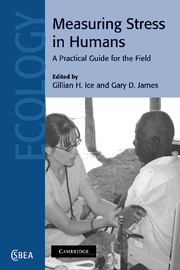Book contents
- Frontmatter
- Contents
- Contributors
- Foreword by Geoffrey A. Harrison
- Part I General principles
- Part II Measuring stress responses
- 2 Cultural dimensions of the stress process: measurement issues in fieldwork
- 3 Measuring emotional and behavioral response
- 4 Measuring hormonal variation in the sympathetic nervous system: catecholamines
- 5 Measuring hormonal variation in the hypothalamic pituitary adrenal (HPA) axis: cortisol
- 6 Measuring physiological changes in the cardiovascular system: ambulatory blood pressure
- 7 Measuring immune function: markers of cell-mediated immunity and inflammation in dried blood spots
- Part III Practical issues in studying stress
- Index
- References
7 - Measuring immune function: markers of cell-mediated immunity and inflammation in dried blood spots
Published online by Cambridge University Press: 11 September 2009
- Frontmatter
- Contents
- Contributors
- Foreword by Geoffrey A. Harrison
- Part I General principles
- Part II Measuring stress responses
- 2 Cultural dimensions of the stress process: measurement issues in fieldwork
- 3 Measuring emotional and behavioral response
- 4 Measuring hormonal variation in the sympathetic nervous system: catecholamines
- 5 Measuring hormonal variation in the hypothalamic pituitary adrenal (HPA) axis: cortisol
- 6 Measuring physiological changes in the cardiovascular system: ambulatory blood pressure
- 7 Measuring immune function: markers of cell-mediated immunity and inflammation in dried blood spots
- Part III Practical issues in studying stress
- Index
- References
Summary
Introduction
Stress is an important determinant of human immune function, but population-level research on the social ecology of immunity has lagged behind other areas of investigation. In large part this is due to methodological constraints associated with the assessment of immune function: venipuncture is a relatively invasive blood sampling procedure that requires the skills of a trained medical professional and, once collected, blood samples must be immediately assayed, or centrifuged, separated, and frozen. Obviously, these are serious impediments to field-based research, and they have hindered the exploration of stress–immunity relationships in large, representative, community-based studies.
Dried blood spots – samples of whole blood collected on filter paper following a simple finger prick – provide an alternative, minimally invasive sampling procedure. Several community-based applications have shown this to be a convenient and reliable means to facilitate sample collection, storage, and transportation, and laboratory methods have been validated for a growing number of analytes (Worthman and Stallings, 1994, 1997; Cook et al., 1998; McDade et al., 2000a; Erhardt et al., 2002; McDade and Shell-Duncan, 2002; McDade et al., 2004). Also referred to as “Guthrie papers,” filter papers have been a core component of US hospital-based newborn screening programs since the 1960s, with all newborns providing a blood spot sample to screen for congenital metabolic disorders (Mei et al., 2001).
In this chapter, detailed information is provided on the collection, handling, and analysis of dried blood-spot samples for two measures of immune activity: Epstein-Barr virus antibodies and C-reactive protein.
- Type
- Chapter
- Information
- Measuring Stress in HumansA Practical Guide for the Field, pp. 181 - 208Publisher: Cambridge University PressPrint publication year: 2006
References
- 1
- Cited by



